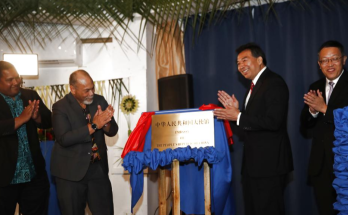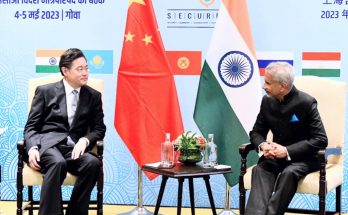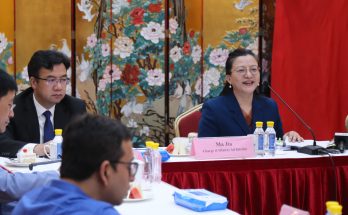I nternational politics and economy are passing through a multi-faceted transition today. It is for scholars to identify the main trends, themes and issues as well as specific challenges and opportunities so that our nations understand each other better. This should allow them to expand their convergences, reduce divergences, and thereby enlarge the arc of cooperation, which alone will help us to promote our national interests in an enlightened and effective manner.
nternational politics and economy are passing through a multi-faceted transition today. It is for scholars to identify the main trends, themes and issues as well as specific challenges and opportunities so that our nations understand each other better. This should allow them to expand their convergences, reduce divergences, and thereby enlarge the arc of cooperation, which alone will help us to promote our national interests in an enlightened and effective manner.
In this context, it may be helpful to spell out India’s worldview as reflected in its contemporary foreign policy. India favours multi-polarity, a multi-polar Asia in a world with several pillars of power of different shapes and sizes. Secondly, India stands for promoting security and development for all, treating the two as inter-linked. Thirdly, it advocates inclusiveness, preferring to work through institutions such as UN and East Asia Summit (EAS) in which all stake-holders are present rather than through alliances that group together a few nations against others. Fourthly, it is pragmatism rather than empty, starry-eyed idealism that drives our policy. We wish to judge nations by their action rather than rhetoric. Our commitment to peace and peaceful co-existence does not preclude vigilance and our readiness to face all other eventualities. Further, India follows a policy of independence, a trait which many scholars consider as reflecting the principle of ‘strategic autonomy’. Finally, our external relations are managed in such a manner that the economic dimension is kept in constant focus. Hence issues like climate change, link between development and energy security, an equitable flow of trade and services, access of developing countries to capital, technology and markets, and South-South cooperation assume considerable importance for us. After listening to your observations, our two sides would need to reflect on where our worldviews converge and where they diverge.
On regional issues, Asia is the primary ground of common interest to both China and India. East Asia faces new tensions and stresses today. Why? We should examine the apparent and underlying reasons. We would suggest (i) empowering EAS to deal with them and (ii) keeping ASEAN’s centrality intact. South Asia is the region where many in India are critical of and express anxiety over China’s strategy and actions. Are the motivations and outcome of China’s policy adversarial to India’s interests? We should exchange views candidly and cordially in order to understand each other’s viewpoints. Central Asia, Afghanistan and Iran suggest convergence of interests between us. What is the degree of convergence and how can we translate it into a programme of cooperation? Finally, West Asia too is important both to China and India: it is about energy security, the region’s strategic importance, our common difficulties with the approach of Western nations and, in India’s case, the diasporic factors. How can we cooperate better? Looking beyond Asia, we should also cover the Indian Ocean, Africa, Latin America and Europe in our Dialogue, either now or at the next session.
Our discussion on regional issues will no doubt be informed, directly or indirectly by our understanding and analysis of the role of Great Powers in world politics today. Our lists of Great Powers and the sequence of their listing may differ, but this segment of our dialogue would allow us to examine the role of, and our relations with, powers such as US, EU, Russia, Japan, ASEAN and others. We will also have an opportunity to exchange views on broader issues like UN reform and India’s strong case for the permanent membership of the UN Security Council. Trends in groupings like G-20, BRICS, SCO etc. should also be discussed in order to identify the ways and means of increasing our cooperation and bridging such trust deficit as may exist.
 We hope to leave ample time to attempt an objective evaluation of our bilateral relations as they stand today. In this context, I recall that ICWA has had the unique distinction of hosting public lectures by your eminent leaders, namely President Hu Jintao, Premier Wen Jiabao and Premier Li Keqiang. Speaking in New Delhi on 21 May 2013, Premier Li Keqiang stated: “In its 70-year history, the ICWA has conducted productive studies on international issues and diplomacy.” He went to add: “Without cooperation and common development between China and India, there will not be a strong Asia or a better future for the world.” We agree.
We hope to leave ample time to attempt an objective evaluation of our bilateral relations as they stand today. In this context, I recall that ICWA has had the unique distinction of hosting public lectures by your eminent leaders, namely President Hu Jintao, Premier Wen Jiabao and Premier Li Keqiang. Speaking in New Delhi on 21 May 2013, Premier Li Keqiang stated: “In its 70-year history, the ICWA has conducted productive studies on international issues and diplomacy.” He went to add: “Without cooperation and common development between China and India, there will not be a strong Asia or a better future for the world.” We agree.
Perhaps we may also need to recognise candidly that our relationship today is marked by an undercurrent of tensions. China and India are neighbours, friends and ‘strategic partners’, but it is also true that many in our two countries and the world at large view us as competitors, rivals and even adversaries too. Our shared challenge is to alter this perception and to allow the relationship to assume a more positive and benign orientation.
This, in our view, will be possible only when the reality of China-India relationship is understood fully. Let us push for deeper cooperation on such complex issues as borders, rivers, markets, people-to-people ties, creation of understanding and trust between two societies, and their place in the world. Relations need to be improved and expanded further through sincere and sustained endeavour. We need to reconcile creatively our interests and our viewpoints through a constructive approach. We should be ready to cooperate and also allow each of us to grow in our own fashion, convinced that there is ample room for both our countries on the world stage today.
(This is the edited version of remarks made by Mr Rajiv Bhatia, Director General, Indian Council of World Affairs at a dialogue on India-China relations, co-organised by the ICWA and Chinese People’s Institute of Foreign Affairs (CPIFA) in Beijing September 2).
Author Profile
Latest entries
 DiplomacyJuly 11, 2014The BRICS journey: Scoring high in Fortaleza
DiplomacyJuly 11, 2014The BRICS journey: Scoring high in Fortaleza China ConnectJune 9, 2014India’s options: Peace and Conflict in East Asia
China ConnectJune 9, 2014India’s options: Peace and Conflict in East Asia India and the WorldOctober 15, 2013Indonesia and India: ‘Companion Souls’ as Strategic Partners
India and the WorldOctober 15, 2013Indonesia and India: ‘Companion Souls’ as Strategic Partners China ConnectSeptember 5, 2013It’s time to alter perception of India and China as rivals
China ConnectSeptember 5, 2013It’s time to alter perception of India and China as rivals






